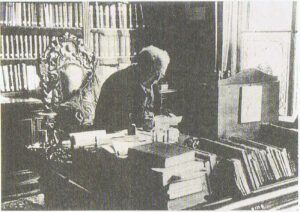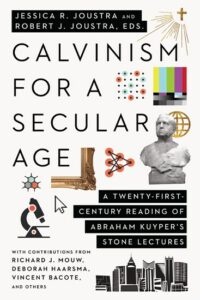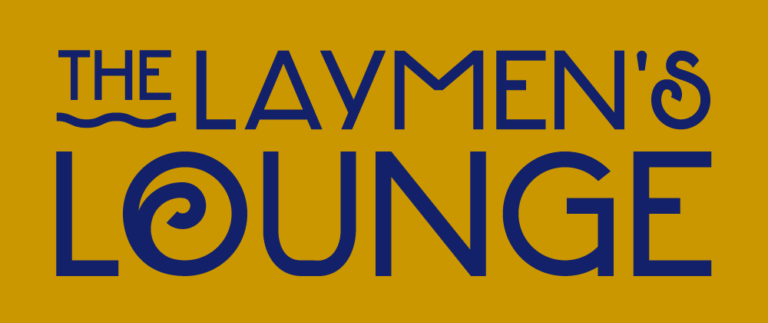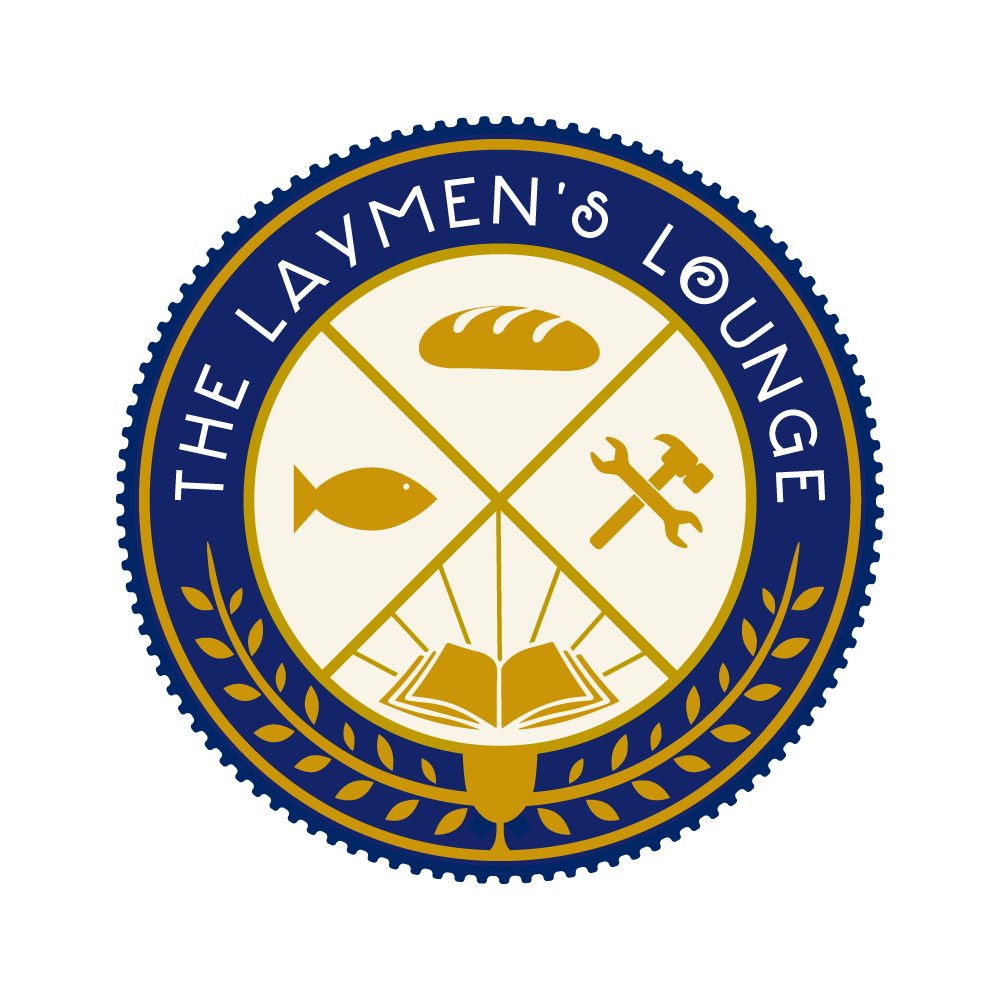An interview with Jessica & Robert Joustra on “Calvinism for a Secular Age: A Twenty-First-Century Reading of Abraham Kuyper’s Stone Lectures” (IVP 2022). Share this interview & tag The Laymens Lounge to be entered to win one of two copies.
“Humanity is no aimless mass of people which only serves the purpose of giving birth to the elect. On the contrary, the world now, as well as in the beginning, is the theater for the mighty works of God, and humanity remains a creation of His hand, which, apart from salvation, completes under this present dispensation, here on earth, a mighty process, and in its historical development is to glorify the name of Almighty God.” — Abraham Kuyper
“Abraham Kuyper loved Calvinism. We might even characterize his passion for Calvinism as unusual; most Calvinists today try to appear as nonthreatening, beer drinking, bearded hipsters. Kuyper was none of those things. [It was a] passion for Calvinism as “a true world and life system.” — Robert Jousrta
Abraham Kuyper, the Dutch Neo-Calvinist theologian, pastor, and politician, was well-known for having declared that there is “not a square inch” of human existence over which Jesus Christ is not its sovereign Lord.
This principle is perhaps best reflected in Kuyper’s writings on Calvinism originally delivered as the Stone Lectures in 1898 at Princeton Theological Seminary. These lectures reflecting on the role of the Christian faith in a variety of social spheres—including religion, politics, science, and art—have become a touchstone for contemporary Reformed theology.
How might the lectures continue to inform the church’s calling in a secular age? In this volume, Jessica Joustra and Robert Joustra bring together theologians, historians, scientists, and others to revisit Kuyper’s original lectures and to critically consider both his ongoing importance and his complex legacy for today.
Join us as we sit down with Jessica and Robert and discuss their own stories and why they are drawn to Kuyper – we discuss what neo-Calvinists, since Kuyper’s lectures, have said, done, and are poised to do.
Reformed, always reforming indeed.
Petrification is not an option.
Pro Rege!
TO BUY THE BOOK, PLEASE CONSIDER DOING SO THROUGH “HEARTS & MINDS BOOKS“
Below are the notes of the most wise Byron Borger on this book and the blessed medium of truth that is Neo-Calvinism (thank you Byron for allowing me to share this mini novella, itself a work of art, here):
On a snowy day last week we got a brand new book that I’ve been waiting for almost a year to see — it means a whole lot to me and its vision and perspective figures a bit into the backstory of why Beth and I founded Hearts & Minds nearly 40 years ago
It is about one of the most important books you most likely never read. We really hope you’ll read my comments below and if you are persuaded, you can send us an order by using the order form at the end of the column at our sale price of 20% off. As always, that links to our secure order form at the Hearts & Minds website.
Some of the authors in this book are people we have met, a few we count as friends, and all are scholars whose work we very much respect. Besides the Joustra’s who so capably guided this whole project, readers will enjoy hearing from the former President of Fuller Theological Seminary and Kuperianista, Dr. Richard Mouw, the fabulous science professor, author, and astronomer Deborah Haarsma (who also is the President of the faith/science organization, BioLogos), the always fabulous Wheaton prof Vincent Bacote, Jonathan Chaplin (now a professor at Cambridge and fellow at Cardus and the UK think tank Theos) and his wife, Adrienne Dengerink Chaplin (who co-wrote the very excellent Art & Soul.) Jim Bratt, who produced the highly regarded, definitive biography of Kuyper, wrote a lengthy preface that is amazing.
I believe this study and contemporary “reading” and application of Kuyper’s Stone Lectures, which became the book Lectures on Calvinism, is a must-read for anyone in the Presbyterian or Reformed tradition, naturally, but, also, for anyone interested in the (hotly debated) question about the relationship of Christ and culture.
That is, what does it mean to think faithfully and live honorably as a follower of Jesus within our 21st-century, post-Christian culture? Quite specifically, how does the notion of a uniquely Christian world-and-life-perspective shape the way we envision things, how we think about and imagine and engage in the areas of the arts, economics, politics, science, race, (and also the church)? How does the Biblical story of God’s good but fallen world being transformed into Christ’s Kingdom actually influence how we think about poverty, justice, beauty, goodness, science and health? What, really, is religion? What should Christians who sincerely pray “Thy will be done, on Earth” think about the future? How shall we live, then, knowing what we know about the goodness of this wonderful world, and the awful fallenness of its sinful condition and of God’s covenantal promises? How does the message of God’s own rule over history and God’s grace in Christ shape us as we live “in but not of” the world around us? Are these not among the most burning questions for people of faith, living out their discipleship hopefully with some intentional spirituality, even of public life? As Steve Garber puts it, how do we have a “seamless life”? Or, as Ashely Hales put it poetically in a wonderful new book, can we have a “spacious life”?
Can some old Dutch theologian who became a public figure — a journalist and politico and eventually prime minister over a hundred years ago — be some kind of guidepost for our own very contemporary considerations? Can some set of lectures given at the end of the 1800s in New Jersey — known as the Stone Lectures — be all that important? Really?
Really?
If you follow what we do here at Hearts & Minds at all, my hunch is that you know what I’m going to say: yes, yes, yes.
Allow me to tell you what the book is about, how the book is arranged, and what it is like. I’ll name a few different kinds of people who might find this book to be a helpful study. It is an amazing volume for a whole bunch of reasons and would be beneficial to all kinds of folks. Here we go.
To understand Calvinism for a Secular Age: A Twenty-First-Century Reading of Abraham Kuyper’s Stone Lectures, edited by Jessica and Robert Joustra,you have to know just a bit about the original Stone Lectures, a prestigious lecture series still given each year at Princeton Seminary; many of the yearly lectures become books, some of which you may know. The first chapter in Calvinism for a Secular Age, a long preface, really, isby historian James Bratt and is worth the price of the book — it is so interesting, informative, and helpful. Bratt explains the theological traditions, movements, factions, and controversies in the late 1800s (that ended up shaping much of the 20th century, actually) when Kuyper arrived by cruiser from Holland to do these significant lectures at one of the world’s leading theological schools; he crisply shows how his lectures might have been received. (A fascinating appendix explores the various manuscripts, in Dutch and in English, done by Rev. Kuyper, first in Holland, and then, perhaps, translated or edited in the US in that fall of 1898. There is a bit of a mystery still unsolved about some conflicting narratives.) The big point is that this stalwart of Christian orthodoxy was going to break some new ground there at Princeton.
Even though the titanic Kuyper’s movement of faith-shaped cultural engagement (having founded a major university, started a daily newspaper, formed a uniquely Christian political party through which he was eventually elected Prime Minister) was gaining popularity (and some controversy) in Europe, it may be that be the more churchy theological types in Jersey didn’t quite realize what sort of a broadly worldviewish, culturally engaging, public theologian they were celebrating with their honorary doctorate that October. With magisterial Reformed theologians like B.B. Warfield and Geerhardus Vos as his hosts, many thought, or so I imagine, that they understood what sort of sacred theology the good Kuyper would present. Bratt seems to imply that Kuyper shocked his guests, or at least provoked them a bit. Ends up that Kuyper’s Calvinism was more than they bargained for.
The first full chapter in Calvinism for a Secular Age is by Rob Joustra and it, too, is just such a good overview of the history of Kuyper’s impact in North America and the impetus for this project re-visiting the Princeton lectures. Those ten pages are wise and good.
Dr. Jessica Joustra, an associate professor at Redeemer University in Ontario and a researcher for a neo-Calvinist think tank in the Netherlands, also worked to put this book together. Her concluding comments — if I may jump to the end of the volume — are, as you’d expect, a stellar voice reminding us of what she calls “worldviewing.” I have already read her dozen pages twice. This whole project reminds us of the unique gifts of this Kuyper tradition and why it matters.

There were not that many people in the room those nights of those handful of lectures in Nassau Hall in 1898, even though it was an august group of thinkers (including a former President of the United States)! There were only 10 or so of the pre-printed, leather bound manuscripts; it would be decades until Eerdmans released the full edition, first in hardback and then in paperback as it is available yet today. The importance of the book, Lectures on Calvinism, has been explored in other volumes and its expression of what has come to be called neo-Calvinism (not to be confused with a rise of hip, young, “New Calvinists” often reported on a decade or so ago) cannot be understated.
In many ways, its visions and challenge — relating the tenets of an evangelical, ecumenical, feisty Protestantism to every sphere of culture — is the backstory and foundations of why Beth and I started Hearts & Minds. A Christian bookstore with sections on architecture and mathematics? A Christian view of farming and engineering, a part of the store dedicated to the arts and popular culture, media studies and science and sexuality? When we opened there were rumors that we were not really a Christian bookstore — who features books on environmental science and racism in a mom and pop Bible bookstore, after all? As one book by a disciple of Kuyper put it in those days, we wanted to “prod the slumbering giant” of the Church, encourage a habit of reading and thinking with “the Christian mind” about all areas of life.
You see, that October at the turn of the 19th century into the 20th, Kuyper explained why, in another context, he wrote about Christ claiming “every square inch” of creation and how no area of life can be “hermeneutically sealed off” from the redeeming power of Christian faith. (That famous line from his inauguration of the Free University of Amsterdam, calling for a coherent Christian worldview that shaped higher learning, was not uttered at Princeton as far as we know.)
The Stone Lectures gave a big (and Biblical) basis for a full-orbed vision of the worldviewish power of religion and how classic Protestant themes (from the likes of Augustine, Johannes Althusius, Luther, Calvin and more) could shape how we think about science and art and politics. If God is sovereign and gracious, as Calvinists insist, what does it mean and what might it “look like” (as we say nowadays) to see God’s ordinances fleshed out in the real world? What might it mean if the reformation was not only about a few church matters and key Biblical doctrines, but unleashed a dynamism that we might even call reformational?
JUBILEE…. and HEARTS & MINDS in DALLASTOWN PA

Is there such a thing as a distinctively Christian approach — and maybe even theories about — science and art and politics, about business and education and history? Kuyper, I want to suggest, authorized us at Hearts & Minds to find books to resource readers for this very notion, helping Christians think well and serve faithfully in law and nursing and schooling and urban affairs, in counseling and media and finances. We have books on relating a Christian framework to the ideas that inform business and technology and government, helping Christians worship as they work by thinking Biblically about their careers and calling. Sound familiar? It was, chiefly, Kuyper who helped American evangelicals — a century later, almost — talk and think and live like this.

JUBILEE – February 27, 2022.

If you have heard us talk about the annual Jubilee conference in Pittsburgh (which, due to the ongoing danger of the Covid spread, is going to be virtual again next month in February 2022) you know that the conference’s “all of life redeemed” vision, this claim that God wants us to serve redemptively in all spheres of life, that God wants to use us to “transform everything” has this Kuyperian tone. Indeed, the CCO (Coalition for Christian Outreach) who founded the conference in the late 1970s learned it from — get this! — sons and daughters of Dutch immigrants who grew up hearing about Kuyper in their homes and schools and churches and moved to Western Pennsylvania to spread this very good gospel.
(Although the previously announced discounts from the old sale is over, you might get a kick out of my long-winded description fo why we remain so eager to tell people about Jubilee, the premier event for Christian college students in the entire nation by looking at some of these old BookNotes columns of us reflecting on how powerful this gathering is and we we’ve been involved in it for so many years. Be sure to come back here, but sometime check out this, this, or this. (That one features a keynote talk I did a few years back.)
We young Jesus movement evangelicals of the 1970s who were struggling with how to relate Sunday to Monday, so to speak, to read “the Bible with the newspaper in the other hand” and to live — as Campolo put it, in his own head nod to Kuyper, it seems to me — as though it is Friday, but knowing Sunday’s coming, needed a comprehensive vision for making all that real, and, in Pittsburgh, we learned about Dutch neo-Calvinism and Abraham Kuyper. We who had heard about Francis Schaeffer saying we should weep for the city and yet rejoice in the arts and care for the earth even as we grapple with the nihilism of late 60s new cinema and existentialist philosophy, we who had heard Tom Skinner and John Perkins condemn institutional racism, we who knew that the Lordship of Christ meant that we must care about social concerns (even if we hadn’t yet read Merton or even MLK much, we at least had heard of John Stott and Ron Sider) — saw in these old Stone Lectures a sort of robust theology, complex philosophy, a curious take on history, and a hopeful future based on nothing less than Jesus Christ, dead, buried, raised, and reigning over His restored creation.
Years before the word “worldview” got co-opted by the religious right and weaponized against others of other faiths, a buddy of mine swore he was getting a Kuyper tattoo as this kind of visionary, comprehensive, orthodox but highly engaged worldview and allowed for pluralism and public justice had just rocked his world.
And I’ve heard there are a few Jubilee tats out there, too. Kuyper’s vision of Reformed public theology lives out in every detail in every sphere of life has been a driving passion for us. It is fascinating to think of where it all came to North America.
Calvinism for a Secular Age tells us a bit about that set of presentations at Princeton that, a century later, had become so generative for so many, providing a plausible foundation for Christian living that somehow was other than the theologically liberal social gospel movement and the overly dogmatic and personalistic neo-fundamentalism of evangelicalism. With the help of some great authors, the Joustra’s compiled this fabulous book exploring the Stone Lectures and updating them for today.
BRILLIANTLY ARRANGED

How it does this is at once brilliant and fairly simple. It is really, really instructive and a great way to get “up to speed” on understanding this seminal work and on learning how those who still stand in this tradition of reformational neo-Calvinism, have worked out the notions Kuyper proposed.
There are a few extra chapters in Calvinism for a Secular Age besides those explores the chapters of Kuyper’s original, offering good contemporary stuff, but the core chapters are arranged like this: an expert in Kuyper’s thought tell us what he said in each chapter of Lectures on Calvinism (again, that is, the book that is based not he Stone Lectures). I’m not going to lie: this was so much more interesting and helpful for me (who doesn’t have tons of time or patience for some of the primary source real heavy stuff) than only reading the real chapters in the Kuyper original. Maybe I shouldn’t say that, but having authors guide us into and summarize his thoughts is not cheating; it is using the gifts of good teachers to help us understand the importance (and limits) of this older content. Where the older book is a bit dry and complex, the parallel chapters explaining things in this new volume are vivid and clear.
The summarizing of each chapter of Lectures is just the first part of the major chapters of Calvinism for a Secular Age. After this introductory explanation of what Kuyper actually said about religion or the arts, or science, or politics, we then have those authors telling us what Kuyperians, those inspired to work out Kuyper’s compelling challenge, have actually done in the 20th century. Just for instance, the arts chapter explores the aesthetic theory of Nicholas Wolterstorff and even more-so, the colorful writing of Calvin Seerveld. The serious chapter about political theory shows how James Skillen (among others) created the Center for Public Justice (CPJ) with their (Kuyperian) commitments to social diversity and both principled and structural pluralism. To see the work of Skillen and his successor, Stephanie Summers, described in this context almost brought tears to my eyes.
And that’s not all. After this explanation of what Kuyper said, and what his tribe has done to work out his general vision in distinctive and reformational ways, the given author in each chapter then tells us what is yet to be done. What should we be thinking and doing within each area to work out Kuyper’s legacy — or reform it, if he was wrong about things, as he surely was in some instances?
So there you have it. Each chapter follows this flow, explaining what was said, how it has been enacted, and what more we might do.
Here is a very candid endorsement by Justin Ariel Bailey, professor of theology at (the Dutch Reformed and intentionally Kuyperian) Dordt University and author of Reimagining Apologetics: The Beauty of Faith in a Secular World. Dr. Bailey says exactly what I want to say:
I have felt ambivalent about Kuyper’s Stone Lectures since I first encountered them. The world and life vision set forth in the lectures are vital to my theological outlook. But Kuyper’s racist asides trouble me deeply, especially when set against tragic appropriations by later interpreters. Calvinism for a Secular Age thus offers a welcome tonic, amplifying my gratitude and acknowledging my grief, making it an essential companion to Kuyper’s lectures. It clarifies his aims, complicates his legacy, and challenges his flaws. When necessary, it moves forward by reading Kuyper against himself. Most importantly, it continues Kuyper’s project, offering a generative and generous vision for all of life, one sorely needed in our secular age.
There are more chapters, too, in the Calvinism for a Secular Age — Kuyper did not tackle the question of race, for instance, and some of his mid-20th century followers used some of his ideas about pluralism (giving social space and freedom for those with different cultures and worldviews) to enact a brutal invention called apartheid in Dutch-colonized South Africa. (That is what Bailey was alluding to, above, I’m sure.) So Jessica and Rob Joustra realized that there needs to be a new chapter as if Kuyper was addressing race today. None other than Kuyper scholar (a black theologian, himself) Vincent Bacote was given the task to create a chapter on what Kuyper thought about race, what Kuyperians (for better or worse) have done in this area, and what we might do to redeem Abraham’s notions to help us think well about race and racism in 21st century. That chapter, too, is one I might say is worth the price of the book. Kudos.
Here are the other chapter titles and authors:
Preface, James D. Bratt
Introduction, Robert J. Joustra
1. Kuyper and Life-Systems, Richard J. Mouw
2. Kuyper and Religion, James Eglinton
3. Kuyper and Politics, Jonathan Chaplin
4. Kuyper and Science, Deborah B. Haarsma
5. Kuyper and Art, Adrienne Dengerink Chaplin
6. Kuyper and the Future, Bruce Ashford
7. Kuyper and Race, Vincent Bacote
8. Lost in Translation: The First Text of the Stone Lectures, George Harinck
Conclusion, Jessica R. Joustra
WHO SHOULD BUY THIS BOOK?
I was going to be a whippersnapper and say “You should” or “Everybody who likes Hearts & Minds,” but I won’t.
I think I can safely say this, though. Here are four sorts of readers who should pick this up.
1. Obviously anyone in the Presbyterian and Reformed traditions. Mainline PC(USA) folks — mostly my tribe — may not know of the Dutch leader’s reception at Princeton or his ongoing impact within our heritage. There is a stained glass window in the chapel of Covenant Seminary in St. Louis (which is aligned with the PCA and ECP) of Kuyper and Warfield at Princeton, but many of the more mainline PC(USA) folks, again, may know not this part of their own history.
That there is such a cool, cultural vibe among many city churches in the PCA tradition (or the young, Reformed, Anglican parishes that are springing up) that highlights a sense of place and offers forums on civic culture and wants to bless their multi-ethnic communities comes not only from their convictions based on Jeremiah 29, say, or the Newbigin/missional church planting ethos, but from a Kuyperian strain that has had remarkable impact in some of our best, missional churches. Tim Keller’s Center for Faith and Work in Manhattan — and its many permutations all over North America — may be idiomatic of the Kuyperian influences in conservative Reformed theology these days. The wisdom about vocation and calling and service in the world bears this influence and you rarely see anything like it within PC(USA) circles.
Some Reformed folks are still stuck in seeing Calvinism less as a story to live out of but a set of five key doctrinal points, and they insist on those five points as being nearly the be-all and end-all of the Christian live. Kuyper thought the Reformed tradition was deeper and better than that, and if you are reading somewhat exclusively in that particular tributary, you really need to see this sort of broader application of God’s promise and deliverance, God’s grit and grace.
Obviously if this is your gig, you get it. But even if this seems aloof from your understanding of what it means to be Reformed, I cannot say enough of how vital this is for those of us in this Reformed tradition to be reacquainted with Kuyper’s impact. All of us Presby and Reformed types should read Calvinism for a Secular Age. (For me, I’ll read it alongside the “Confession of 1967” and Barman and Belhar in our PC(USA) Book of Confessions.)
2. Anyone interested in history or, certainly, in historical theology should snatch this right up. My, my, we are glad that in recent decades we are seeing all sorts of folks — including mainline Protestants and evangelicals — reading Aquinas and Augustine; there is a good rediscovery of Wesley and although I have my issues, I smile when I see those Jonathan Edwards is my Homeboy tee shirts. I love the way folk from various quarters are quoting Luther. From the movement interested in Mercersburg theology to the huge renaissance in the Patristics (not to mention new energy coming out of Barth and Bonhoeffer studies) there is much to be learned from older (granted, mostly white) dead guys. Yet, even many who know church history well are unaware of this chapter of North American protestantism.

(Here might be a place to insert a plug for Devotional Classics: Selected Readings for Individuals and Groups so wonderfully edited by Richard Foster, published by HarperOne; [$14.99) which offers excerpts of primary source historical spiritual writers across several broad traditions, men and women whose old works are so very useful today. There’s no Kuyper in here, even though he was famously pious and prayerful, but this remains a fantastic, ecumenical resource.)
A friend of mine studying at an Episcopalian seminary under the extraordinary Dr. Katherine Sonderegger, sent me a picture she snapped, of Dr. S writing on the class blackboard “Abraham Kuyper” and “common grace.” I don’t know if my friend read Richard Mouw’s book about common grace, All That God Cares About (that mentions Beth and me as I tell about how Dutch Kuyperians influenced our early days of Hearts & Minds) but she knew enough to know I’d be tickled and sent the serendipitous shot as a text. Kudos to Dr. Sonderegger suggesting even future Episcopal priests should know this stuff. Enough said.
3. This book is important for those interested in faithful engagement in contemporary issues of race, peace, justice, political discipleship, and public theology. In other words, almost everybody who reads BookNotes and who at least cares a little about some of the “square inches” of God’s good creation or who longs for a renewed public life. Kuyper and Kuyperians are a curious lot, who (whether they lived it out well or not) claim to believe that we are neither right nor left, neither conservative nor liberal, but quite foundationally, something like a third way
There is way too much destructive and heretical complicity among the religious right with violent populism and white nationalism and the like. All the talk about personal freedom and such strikes me as an idolatrous ideology from the secular Enlightenment and not Biblical or Christ-like. It concerns me a bit less at the moment, but there is often a knee-jerk predictability among even our well-intentioned Christian social justice warriors, too, some of whom oddly seem to appreciate the secular ideologies of Karl Marx.(Of course not all Christian conservatives are part of the Trumpian alt-right and not all Christian progressives are secular Marxists; in fact, most are not, making their alliance with distressing ideologies more covert and thereby maybe more dangerous.) All of us tend to suppose that God thinks like we do and we’ve all sometimes imagined the Kingdom of God in ways that just happen to suit our own dispositions. Kuyper tries to get us beyond that. We all need him to help keep us honest, especially if we are engaged in ministries in the public square.
Just the other day I was reflecting with a friend who noticed that some Kuyperians are really pretty right wing but the ones I most often quote are not. Fair enough. It’s weird to know that nuts like Josh Hawley and Reformed thinkers who nearly gave their lives for liberation for tortured South Africans like Alan Boesak both have quoted Kuyper. How can Edith Schaeffer and Kristen Du Mez both be influenced by the same intellectual movement? There it is, though: like the Wesleyans or the Jesuits or those who take up the BCP, Kuyperianism is a wild and diverse movement. Maybe that is part of why I recommend it at this cultural moment. Left, right, or center, we need some reconsideration and some fresh ideas. Give this a try, please.
4. Those who don’t care. I suppose you are not still reading if this is you, but if so, thanks for hanging in there with me. I’m glad you honor me enough to at least keep reading my reviews. If talking about a distinctively Christian approach to faith and culture, if drawing on the past to better understand today, if thinking about old stuff to energize us anew in non-ideological ways just doesn’t work for you, I get it. But, come on — lots of people say we should read old books, and this is a painless way into that older, ongoing conversation.
I hope you know one of the very best books of last year, now in paperback, the stunning Breaking Bread with the Dead: A Reader’s Guide to a More Tranquil Mind. Alan Jacobs reminds us there of the value of hearing those from other times and places and while the Joustra’s good work of bringing together contemporary Kuyperian aficionados means that Calvinism for a Secular Age isn’t an old book, it at least explores and works with and talks back to and invites living out of an old book. I don’t know if this counts for C.S. Lewis’s admonition to read plenty of old books, but I think it is “breaking bread with the dead.” Come on! You can do this!
+++

If that stirred you, please visit Hearts & Minds Books to purchase the book:
We here at the Layman’s Lounge are glad you’ve enjoyed our latest offering. We believe deeply in the Lordship of Christ over all of life and are eager to think about even how to shop to the glory of God. That might mean, we’d suggest, supporting human-scale businesses that do good work, that are in some ways consistent with our hopes to see a reformation in culture and in the habits of our public lives. To that end, we’d invite you to order any books mentioned here from our friends at Hearts & Minds, a family-owned, indie bookstore in Dallastown PA. Use the promo code LL20 (or just say you heard about them in the Lounge) and they will deduct 20% off your order (and do listen to our interview with Byron Borger, the great curator/owner of Hearts & Minds here). (There may be a few exceptions if books are out-of-print, self-published or rare.) Just type in what you want at the interactive, secure order form at their website: www.heartsandmindsbooks.com or send Byron an inquiry at read@heartsandmindsbooks.com. You can call them at 717-246-3333.


